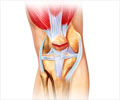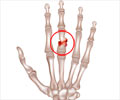- Scaphoid (Navicular) Fractures of the Hand and Wrist - (http://www.uwhealth.org/sports-medicine/scaphoid-navicular-fractures-of-the-hand-and-wrist/11483)
- Colles' Fracture (Distal Radius Fracture or Broken Wrist) - (http://www.webmd.com/a-to-z-guides/scaphoid-fracture-of-the-wrist-overview)
- Scaphoid Fracture of the Wrist - (http://orthoinfo.aaos.org/topic.cfm?topic=a00012)
About
The scaphoid is a small bone of the wrist that is located at the base of the thumb, immediately above the radius bone, where the wrist bends. It is seen when the thumb is held in a hitch-hiking or thumbs up position.
The wrist comprises of two long bones, the radius and the ulna, and eight smaller carpel bones. The eight carpels, of which the scaphoid bone is one, are arranged in two rows of four bones. They are found between the metacarpals (bones on the palm) and the radius and ulna(bones of the forearm). The scaphoid bone is located in a depressed area, also known as the “anatomical snuff box” which lies at the base of the thumb.
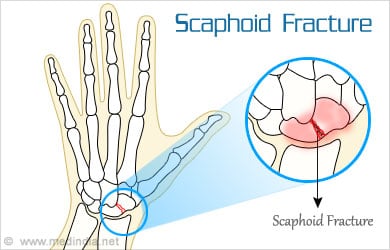
The scaphoid bone, also known as navicular bone, is highly prone to breakage, hence, fractures are quite common in this area. Typically, a scaphoid wrist fracture occurs when a person falls on the palm, with a hand outstretched. During such a fall, the scaphoid becomes compressed against the radius of the forearm, causing a fracture.
It is important to detect a scaphoid fracture and treat it at the earliest. These fractures heal slowly; if the healing is not complete the injury can lead to lifelong complications such as stiffness, chronic pain and arthritis.
A scaphoid fracture is usually caused when you land your weight on the palm of an outstretched hand while trying to protect yourself during a fall. The fracture can also occur when the wrist twists severely or when the palm of the hand hits a hard surface with force. Depending on the impact the radius may also break.
Scaphoid fractures occur in people of all ages but more commonly in men aged between 20-30 years. There is no particular disease or specific risks that predispose a person to scaphoid fractures. However, they are common in those engaged in sporting activities such as football, basketball, skateboarding, or bike riding and also in those caught in a car crash or engaged in a fistfight.
Scaphoid fracture - Symptoms
A scaphoid fracture may not be too evident to a naked eye unless the wrist is deformed. In some cases, where the pain is not too severe, the fracture may be mistaken for a sprain.
Common signs and symptoms of a scaphoid fracture -
- Pain and swelling at base of thumb
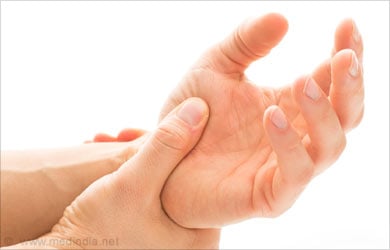
- Tenderness at the anatomical snuffbox of the wrists
- Severe pain on moving wrists or while gripping an object
Pain that does not resolve within a day is often indicative of a fracture. You should see the doctor immediately.
Complications
- Non union - This common feature that occurs after a scaphoid fracture is a bone that fails to heal. It occurs as a result of poor blood supply. A bone graft might be considered to treat a non union.
- Avascular necrosis - When the bones are displaced in a scaphoid fracture, the blood supply to these bones may be disrupted causing a poor supply of nutrients. This is avascular necrosis. A vascularized bone graft is the best possible treatment.
- Arthritis - Arthritis of the wrist can occur over time after a scaphoid fracture. Anti-inflammatory medications and / or wearing a splint may be the methods of choice treatments. If all this proves ineffective, surgery may have to be done
Scaphoid Fracture - Diagnosis
It is important that scaphoid fractures are diagnosed and treated at the earliest to make complete healing possible. Also, if there is bone displacement, medical intervention is imperative and if this is not soon enough it is possible that the bone disintegrates and necrosis sets in. A person with a scaphoid fracture will have pain and swelling in the injured wrist and this usually force him to seek medical help.
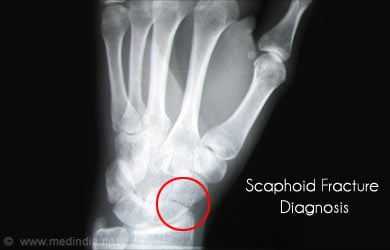
The doctor will question you regarding your symptoms and the manner in which you hurt yourself. He will then examine your wrists for swelling and tenderness, assess your hand and wrist movements and will also check the blood flow to your wrists. X rays would reveal if there is a broken bone or if there is a gap between the broken bones (displacement). In some cases, despite the swelling and the pain, the fracture may not be visible on the X-rays. In such cases the doctor would advise you to wear a splint and rest your hand for a week or two. A new X-ray would be recommended to see if the fracture is visible. In some cases the fracture would be visible only on a magnetic resonance image (MRI) scan.
Treatment
Non-surgical Treatment
Treatment of scaphoid fractures is usually based on the location and severity of the injury and the shape of the fracture line.
Fractures where the break is small and the bone not displaced is treated by immobilizing the hand. Those fractures that are closer to the thumb have better blood supply and are therefore, likely to heal in a couple of weeks. As part of the treatment your hand will be placed in a cast below the elbow and this may or may not include the thumb. Periodic X-rays or other imaging tests will help to monitor the healing progress which is likely to vary between individuals.
If the fracture is near the forearm healing becomes difficult and takes more time as the blood supply to this area is limited. In such cases, the injured hand is placed in a cast that extends above the elbows and will include the thumb.
Some doctors prefer to keep the hand in a long cast for about six weeks and then use a shorter cast until the fracture is healed. Others advocate a short cast for three months, and this is to be followed by a rigid splint for about two months. You may indulge in everyday activities once the hand is immobilized, as long as you don’t experience pain or discomfort. If non-displaced fractures do not heal even after 2-3 months you may need surgical intervention and electrical stimulation to rectify the problem.
Surgical Treatment
Fractures in which the bones are displaced require surgery and this may include bone grafts, screw and/or wires for proper fixation. The size of the incision is dependent on the part of the scaphoid bone that is broken. It may be made on the front or back of the wrist. If the scaphoid bone is broken into two or more pieces, a bone graft may be required. A graft is usually a piece of bone taken from the forearm of the same hand. Sometimes it is a fragment of the hipbone. The graft is placed in the area of the broken bone to stimulate bone formation and healing. The hand must be placed in a cast after surgery until it is healed.
While wearing a cast there are certain things that you need to follow -
- Avoid using the injured arm
- Avoid contact sports
- Avoid climbing trees, ladder
You may develop stiffness if the cast is worn for a long period or if the fracture requires more surgical repairs.
Exercises
It is very important to maintain full finger motion throughout the recovery period. For this, your doctor will recommend an exercise program and hand therapy throughout your recovery period to promote full finger motion which will help you regain strength and motion in your wrists. These exercises will have to be continued till the hand strength and motion returns to normal after which you will have to wear protective braces during stressful activities for three months or more.
Common exercises that are done after the cast is removed are mentioned below -
Wrist flexion: In your hand, hold a can of soup or a hammer handle, with your palm facing you. Bend at the wrist, first moving your palm up and then lowering it to the starting position. Do this as three sets of ten each.

Wrist extension: Repeat the same exercise with your palm facing down. Do this as three sets of ten each.
Finger extensions: Placea rubber band around your fingers and spread the fingers slowly and then come back to original position.
Supination and pronation: After bringing your arm to your side bend your elbow to 90 degrees, turning your palm up. Hold a hammer in your hand tightly. Turn your hand so that your palm faces down and then bring it back up. Do this as three sets of ten each.
Ball squish: Hold a squeezable ball in your hand and squeeze it tightly for 5 seconds. Do this 15 times.
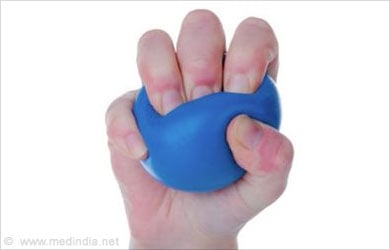
Despite various therapies, some people are unable to recover their previous level of strength and motion in their wrists.
There is plenty of research being done regarding the treatment of scaphoid fractures. Research is being carried out on different bone grafts that improves healing. Other areas of research includes injury prevention using new types of wrist wear and newer imaging studies for early diagnosis.


